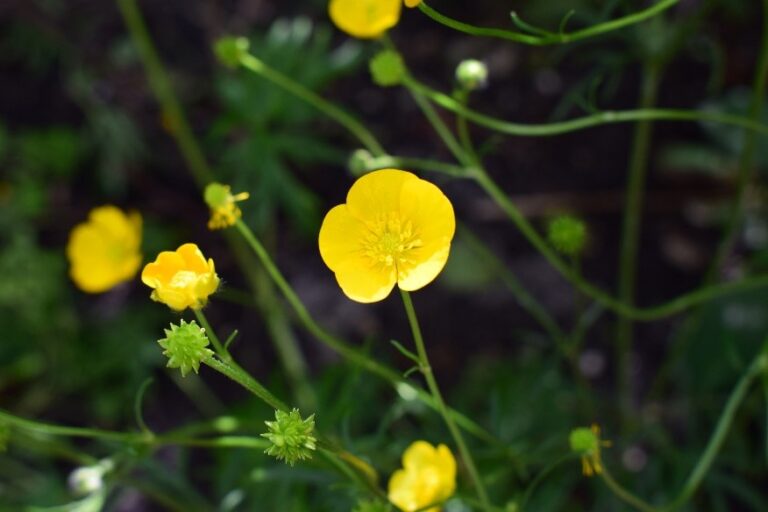


Stamens 15-20.įruits: achenes, 100-250 in a cylindrical cluster, obovate in outline, about 1 mm long, flattened, the central portion of the face smooth and set off from the edges by a distinct depression. Receptacle in fruit ellipsoid-cylindric, up to 14 mm long, usually slightly short-hairy. Nectary scale 1 mm long, largely joined to the petal, the edges and base forming a slight pocket bordering and partially covering the exposed gland. Sepals 5, spreading, yellowish, 2-4.5 mm long, soon dropped. Stem leaves numerous, alternate, more deeply cleft or divided than the basal leaves.įlowers: several on stalks rather stout, 1-3 cm long. Leaves: the basal with a stalk 2-4 times as long as the blades, the blade reniform in outline, mostly 2.5-4 cm long and deeply 3 (or apparently 5)-parted into more or less wedge-shaped, and again less deeply once- or twice-lobed or toothed. Stems 1 to several, erect, 20-50 cm tall, usually freely branched, hollow. Phone 08 98444064 or for more information.General: hairless to sparsely stiff-hairy annual with numerous slender, fleshy roots. P66.Īcknowledgments:Collated by HerbiGuide. (Western Australian Herbarium, Department of Agriculture, Western Australia). Marchant, N.G., Wheeler, J.R., Rye, B.L., Bennett, E.M., Lander, N.S. CSIRO handbook of economic plants of Australia. Diagram.Ĭunningham, G.M., Mulham, W.E., Milthorpe, P.L. (Australian National University Press, Canberra). Flora of the Australian Capital Territory. (Government Printer, Adelaide, South Australia). An illustrated botanical guide to the weeds of Australia. Plants of similar appearance: References:Īuld, B.A. Snakes tongue Buttercup ( Ranunculus ophioglossifolius) Smooth Buttercup ( Ranunculus pentandrus) Small River Buttercup ( Ranunculus amphitrichus) Small flowered Buttercup ( Ranunculus sessiliflorus) Small flowered Buttercup ( Ranunculus pumilio) Small flowered Buttercup ( Ranunculus parviflorus) Pale Hairy Buttercup ( Ranunculus sardous) Large Annual Buttercup ( Ranunculus trilobus) Treatment:Remove stock from infested areas.Ĭelery Buttercup ( Ranunculus sceleratus)Ĭreeping Buttercup ( Ranunculus repens) is very similar but has long stolons and the beaks of the achenes are less curved and almost erect. Toxicity:Sap constituent, protoanemonin, can cause colic and inflammation in animals. More palatable to cattle than sheep.ĭetrimental:Weed of poorly drained pastures and disturbed areas. Plant Associations:Sclerophyll forests to alpine woodlands and swamps.įodder. In Ranunculus colonorum the petals are narrower and the sepals turned downward, rather than erect or spreading and it is more common in WA whereas Ranunculus lappaceus is more common in the eastern states.Īllelopathy: Population Dynamics and Dispersal:ĭistribution:ACT, NSW, QLD, SA, TAS, VIC, WA. Ranunculus lappaceus and Ranunculus colonorum are very similar and often confused. Seed Biology and Germination: Vegetative Propagules: New season growth emerges from rootstock in autumn.įlowering times:Spring and summer in western NSW. Grows mainly in winter and spring and top growth dies in summer. Wheeler.Īnnual stem, perennial rootstock. Nectary lobe cuneate and broader than long.Īchenes smooth in a globular head and hairless with rigidly curved, 1-2 mm long beaks.įrom J.M. Petals yellow, broadly obovate to cuneate. Key Characters:Leaves alternate or radical with broad, flat lobes, mainly radical, stem leaves smaller.įlowers regular, not spurred, 20-40 mm across. Slender, narrow curved or coiled beak, 1-2 mm long. 2-5 mm long by 2.5-4 mm wide, smooth, edges ridged. Achenes, flattened, egg shaped in outline. Nectary lobe, wedge shaped, broader than long.įruit:Globular cluster of achenes. Petals - 5 yellow, broad, smooth and shiny, egg shaped to triangular, 9-25 mm long with nectar pit at the base. Sepals - 5 egg shaped to oblong-oval, 4-8 mm long, spreading, overlapping. With dense, spreading hairs.įlower head:2-8 flowers per stem on long erect stalks. Stems: Usually erect, 20-600 mm high, branched. Stem leaves - Fewer, much smaller with narrow lobes or narrow oval shaped. Each segment usually has 3, toothed lobes or is deeply divided. Divided in sets of 3, toothed lobes or 3 stalked segments. Petiole - 50-180 mm long, with papery, clasping, sheathing bases.īlade - Egg to wedge shaped in outline. Summary:A softly hairy, erect perennial herb up to 600 mm high with bright yellow flowers and 3 segment, divided leaves. Ranunculus is Latin for tadpole from the Latin rana meaning frog and may refer to the damp habitats preferred by many species in this genus.Īustralian Buttercup because it is an Australian native with rich yellow, butter coloured, cupped type flowers. Australian Buttercup Australian Buttercup


 0 kommentar(er)
0 kommentar(er)
